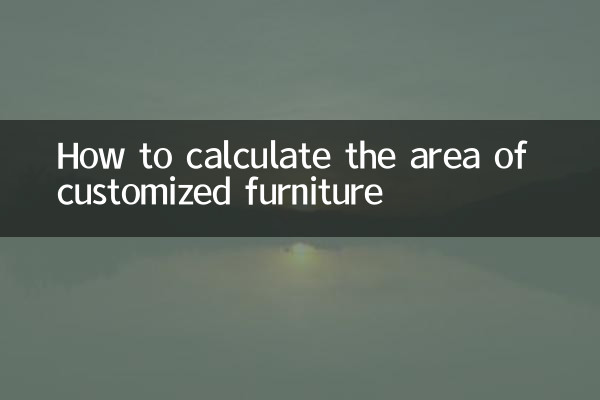How to calculate the area of customized furniture: analysis of hot topics on the Internet in the past 10 days
With the arrival of the home decoration peak season, how to calculate the area of customized furniture has become the focus of consumers' attention. In the past 10 days, the amount of discussion on customized furniture has surged across the Internet, especially topics such as pricing methods, pitfall avoidance guides and material selection have remained high. This article will combine recent hot topics to provide you with a detailed analysis of the area calculation method of customized furniture and provide structured data reference.
1. Comparison of mainstream pricing methods for customized furniture

| Pricing method | Applicable scenarios | advantage | shortcoming |
|---|---|---|---|
| Projected area | Wardrobes, bookcases and other cabinets | Simple calculation and transparent price | Internal structural changes may affect total price |
| Expanded area | Complex structure furniture | Calculated based on actual materials used | The calculation is complex and prone to disputes |
| unit pricing | Standardized customized products | Modular combination, high cost performance | Limited personalization |
2. Detailed explanation of projection area calculation (recent hot search TOP1)
According to data from a home furnishing platform, searches for "projection area" have increased by 230% year-on-year in the past seven days. The calculation formula is:
Projected area = furniture width × height
| furniture type | Regular size (mm) | Projected area (㎡) |
|---|---|---|
| double door wardrobe | 1200×2200 | 2.64 |
| three door wardrobe | 1800×2200 | 3.96 |
| bookcase | 1500×2000 | 3.00 |
3. Key points for calculation of expanded area (controversial hot spots)
Recent data from a complaint platform shows that disputes over expansion area account for 42% of complaints about custom furniture. Please note when calculating:
1. The total area of all panels
2. Including back panel, shelf panel, side panel, etc.
3. Special shapes need to be calculated separately.
| Board type | Thickness(mm) | Unit price reference (yuan/㎡) |
|---|---|---|
| particle board | 18 | 120-180 |
| multilayer solid wood | 15 | 200-280 |
| Ecological board | 17 | 160-220 |
4. The five issues that consumers are most concerned about recently
1. How to calculate the area of special-shaped furniture? (Hot search index: ★★★★★)
2. Is the area deducted for door and window openings? (Hot search index: ★★★★☆)
3. Is the area included in the package sufficient? (Hot search index: ★★★☆☆)
4. How big is the difference in unit price of different materials? (Hot search index: ★★★☆☆)
5. Is the design fee included in the area? (Hot search index: ★★☆☆☆)
5. Guide to avoid pitfalls (the most forwarded in the past 10 days)
1. Confirm the pricing method before signing the contract
2. Request the merchant to provide detailed dimensional drawings
3. Compare quotations from more than 3 companies
4. The balance will be left to be paid after acceptance.
5. Pay attention to whether hardware accessories are charged separately.
According to data from an e-commerce platform, 67% of orders are priced using projected area, while only 23% choose expanded area. It is recommended that consumers choose the appropriate pricing method based on the complexity of the furniture. For simple cabinets, priority is given to the projected area. For complex structures, the expanded area can be considered, but be sure to ask the merchant to provide a detailed list.
Recently, many home bloggers have reminded that there are "three invisible additions" in the calculation of the area of customized furniture: visible panels, closing strips and special-shaped cutting. These items are often not included in the initial quote, but may add 15%-30% to the total cost. Consumers are advised to pay special attention to these detailed terms when signing a contract.

check the details

check the details